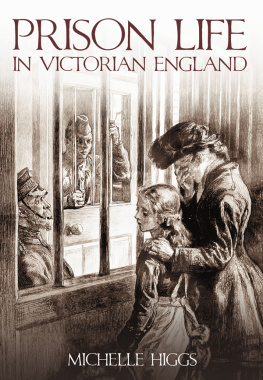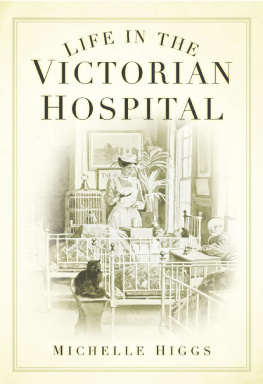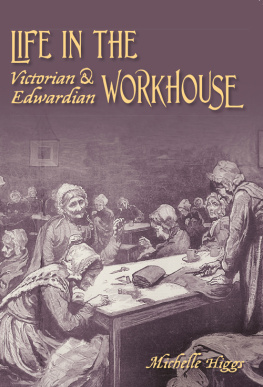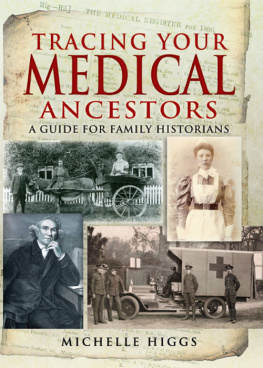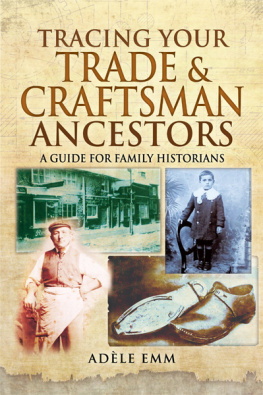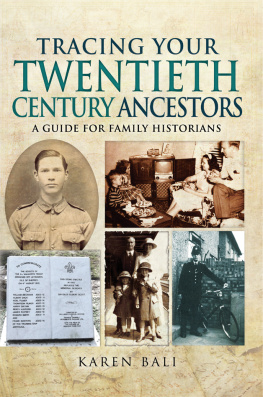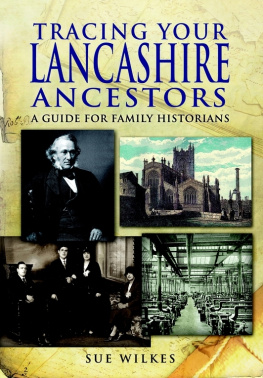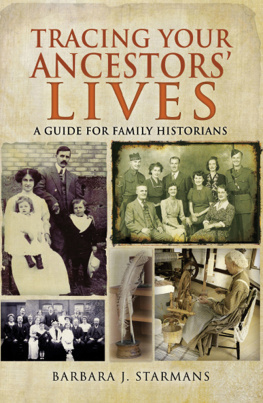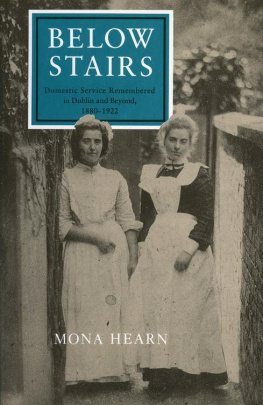
FAMILY HISTORY FROM PEN & SWORD
Tracing Your Army Ancestors
Simon Fowler
Tracing Your Pauper Ancestors
Robert Burlison
Tracing Your Textile Ancestors
Vivien Teasdale
Tracing Your Railway Ancestors
Di Drummond
Tracing Secret Service Ancestors
Phil Tomaselli
Tracing Your Royal Marine Ancestors
Richard Brooks and Matthew Little
Tracing Your Jewish Ancestors
Rosemary Wenzerul
Fishing and Fishermen
Martin Wilcox
Tracing Your East Anglian Ancestors
Gill Blanchard
Tracing Your Ancestors
Simon Fowler
Tracing Your Liverpool Ancestors
Mike Royden
Tracing Your Scottish Ancestors
Ian Maxwell
Tracing Your Criminal Ancestors
Stephen Wade
Tracing Your Labour Movement Ancestors
Mark Crail
Nick Barratts Beginners Guide to Your
Ancestors Lives
Nick Barratt
Tracing Your London Ancestors
Jonathan Oates
Tracing Your Shipbuilding Ancestors
Anthony Burton
Tracing Your Northern Irish Ancestors
Ian Maxwell
Tracing Your East End Ancestors
Jane Cox
Tracing the Rifle Volunteers
Ray Westlake
Tracing Your Legal Ancestors
Stephen Wade
Tracing Your Canal Ancestors
Sue Wilkes
Tracing Your Rural Ancestors
Jonathan Brown
Tracing Your Tank Ancestors
Janice Tait and David Fletcher
Tracing Your Family History on the Internet
Chris Paton
Tracing Your Medical Ancestors
Michelle Higgs
Tracing Your Second World War Ancestors
Phil Tomaselli
Tracing Your Channel Islands Ancestors
Marie-Louise Backhurst
Great War Lives
Paul Reed
The Territorials 19081914
Ray Westlake
Womens Lives
Jennifer Newby
Tracing Your Naval Ancestors
Simon Fowler
Family Matters
Michael Sharpe

First published in Great Britain in 2012 by
PEN & SWORD FAMILY HISTORY
an imprint of
Pen & Sword Books Ltd
47 Church Street
Barnsley
South Yorkshire
S70 2AS
Copyright Michelle Higgs 2012
ISBN 978 1 84884 611 1
ISBN 978 1 84468 409 0 (ebook)
The right of Michelle Higgs to be identified as Author of the Work has been asserted by her in accordance with the Copyright, Designs and Patents Act 1988.
A CIP catalogue record for this book is available from the British Library.
All rights reserved. No part of this book may be reproduced or transmitted in any form or by any means, electronic or mechanical including photocopying, recording or by any information storage and retrieval system, without permission from the Publisher in writing.
Typeset in Palatino and Optima by
CHIC MEDIA LTD
Printed and bound in England by
CPI Group (UK), Croydon, CR0 4YY
Pen & Sword Books Ltd incorporates the imprints of Pen & Sword Aviation, Pen & Sword Maritime, Pen & Sword Military, Wharncliffe Local History, Pen & Sword Select, Pen & Sword Military Classics, Leo Cooper, Remember When, Seaforth Publishing and Frontline Publishing
For a complete list of Pen & Sword titles please contact
PEN & SWORD BOOKS LTD
47 Church Street, Barnsley, South Yorkshire, S70 2AS, England
E-mail: enquiries@pen-and-sword.co.uk
Website: www.pen-and-sword.co.uk
CONTENTS
W hile writing this book, I received help and advice in locating information and illustrations from a number of different sources. For this assistance, I would like to express my gratitude to the staff of Birmingham Archives and Heritage Service, Dudley Archives and Local History Service, and Lancashire Archives; and to Valerie Wardlaw of Falconer Museum, Forres.
I would also like to thank Alan Mackie and Carolyn Middleton who were so generous with their time and their research.
Finally, I would like to thank my husband Carl for his patience and support, and my family and friends for their encouragement during the writing of this book.
E very effort has been made to trace copyright holders of images included in this book. The publishers would be grateful for further information concerning any image for which we have been unable to trace a copyright holder.
W ith more than 1.3 million domestic servants listed on the 1911 census, it is not surprising that many thousands of people today have a servant in their family tree. From the veritable army of staff kept by the gentry to service their country houses to the lowly maid of all work employed by tradesmen and shopkeepers, there was a world of difference for the servant in terms of accommodation, wages and working conditions.
If you have an ancestor who was in domestic service, it is possible to find out more from general sources and specific servant-related records. However, the likelihood of finding your forebear in the sources depends to a large extent on when and where he or she lived and worked. Generally, you are more likely to find your ancestor if he or she was working in the mid- to late nineteenth century, or worked on a landed estate, or was sent into service by a poor law union or charitable organisation.
Even if you cannot find your forebear listed in any of the relevant sources, it is still possible to get a clearer picture of his or her working life from contemporary household manuals, and diaries and autobiographies of servants.
This book aims to give an overview of the role and places of work of domestic servants from the eighteenth century up to the Second World War. However, it will concentrate primarily on the nineteenth century as this was the heyday of the domestic servant. The book will look at the sources which can be used to trace those in service including printed records, original documents and some online sources.
In the bibliography, you will find the titles of more detailed publications about domestic service. The appendices include useful contacts listing relevant archives and libraries, as well as places to visit with servants quarters.
Throughout the book, you will find case studies of real people who worked in domestic service. The sources section discusses a variety of records in greater detail, showing how they can be used to trace your own servant ancestor. This book assumes you have no previous knowledge of family history, but if you already know the basics of genealogical research, simply dip into the sections you are most interested in.
DOMESTIC SERVICE
DOMESTIC SERVICE THROUGH THE CENTURIES
T he working-class origins of domestic servants in the Victorian era were almost unrecognisable from those who served in the castles and manors of the medieval period. At this time, men of gentle birth were routinely found among the upper servants in noble houses. According to Dorothy Marshall in The English Domestic Servant in History, this was because the belief that there was nothing degrading in performing even the most menial tasks for the well-born still held. It was also still customary for young men of good social standing to attend on the nobility as part of their training. Officials such as the clerk of the kitchen or the gentleman usher were carrying out tasks connected with running the domestic household which were similar to that of the later butler, but they were almost always well-bred.
Next page

